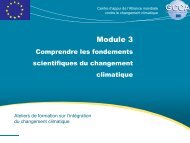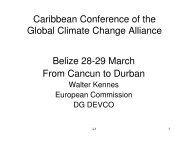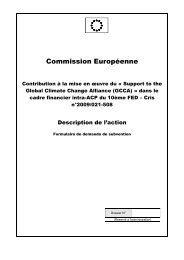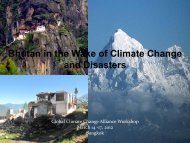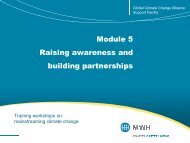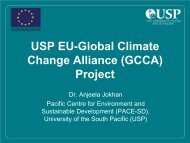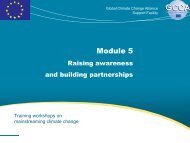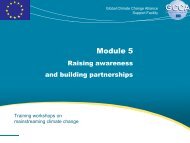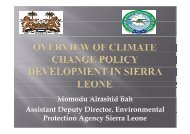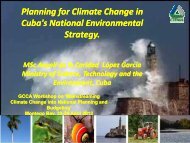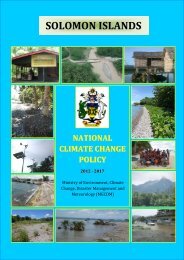Chapter 2<strong>Rwanda</strong> hosts deposits of gold, tin, tungsten, coltan and gemstones, though resources and reservesare unknown as minimal exploration drilling has been done. Even though the mining industry is small, itcontributed 38% of <strong>Rwanda</strong>’s export earnings in 2010 with USD96.4 million, and has the potential to tripleproduction by 2020. There is also significant potential for value addition and product diversification throughprocessing of domestic and imported ores and manufacturing of construction materials and jewellery, andpotential to develop a mining services industry for the country and the region.<strong>Rwanda</strong> is landlocked and has limited transport infrastructure, with no rail link to the ocean and fewall-weather roads. It is entirely dependent on oil imports which accounted for 16% of total imports by costin 2010. This results in very high transport charges, accounting for some 40% of costs. <strong>Rwanda</strong> joined theEast African Community (EAC) in 2005 and has since more than doubled trade with EAC partner states toUSD600 million in 2010. <strong>Rwanda</strong> is a net importer in the EAC and is aligning its budget, trade, andimmigration policies with its regional partners. <strong>Rwanda</strong> was admitted to the Commonwealth in 2009.<strong>Rwanda</strong>’s main energy source is biomass, sourced mainly from on-farm trees and plantations of fastgrowing eucalyptus trees. Access to electricity is increasing, with 13% of the population currentlyconnected, though this is centred on the capital city, Kigali, and there remains limited access in rural areas.Electricity generation capacity is low at 95MW, dominated by hydropower and oil-fuelled power plants, anddomestic electricity prices at USD 0.24/kWh are still high. <strong>Rwanda</strong> has over 1,000MW potential, fromgeothermal power, methane gas, peat deposits, biogas, regional hydropower, small scale hydro and solarPV. This would provide enough power to meet energy demand (maximum 400MW by 2020) and allow<strong>Rwanda</strong> to export electricity.Industry employs 4% of the national workforce and contributes 14% to GDP, half of which comesfrom the construction sector, with a target of 26% of GDP by 2020. Manufacturing is dominated by foodprocessing, beverages and tobacco. Micro, small and medium enterprises, both formal and informal,comprise 98% of businesses in <strong>Rwanda</strong> and 41% of all private sector employment. Services currentlycontribute 45% to GDP and are dominated by wholesale and retail trade (14%), real estate and businessservices (10%) and transport and communication (8%). Tourism is one of <strong>Rwanda</strong>’s largest foreignexchange earners, grossing USD207 million in 2010, due largely to gorilla tracking in Volcanoes NationalPark, and ecotourism in Nyungwe Forest and Akagera National Park.<strong>Rwanda</strong>’s low tax revenue, narrow export base and limited infrastructure led the Government of<strong>Rwanda</strong> (GoR) to embark on a programme of mobilising private investments in industry and services. TheInformation and Communication Technology (ICT) sector is considered a flagship for the country’s economicprosperity and a tool for transforming the <strong>Rwanda</strong>n economy. 2,300km of fibre optic cables have recentlybeen laid across the country in an effort to provide broadband access and make <strong>Rwanda</strong> one of the mostconnected countries in Africa.<strong>Rwanda</strong> has seen impressive economic growth of 8.5% GDP per year for the past 5 years andrecent reforms in doing business have gained <strong>Rwanda</strong> international recognition and increased foreigninvestment. GDP reached USD5.5 billion in 2010, translating into USD541 per capita, a large improvementfrom USD200 in 2000. With political stability, well-functioning institutions, rule of law and zero tolerance forcorruption, <strong>Rwanda</strong> is an attractive place to invest. Foreign investment opportunities lie in agriculture (teaand horticulture), power generation, tourism, infrastructure and mining. <strong>Rwanda</strong> has a trade in goods deficitof over USD1 billion (20% of GDP) with imports five times larger than exports.6Government of <strong>Rwanda</strong>
Chapter 22.2 Development Challenges<strong>Rwanda</strong> is a unique country with many distinctive features that play a role in its development. Itsdemography, natural resources, current economic base and governance will largely determine itsdevelopment in the coming decades. Current challenges for economic development in <strong>Rwanda</strong> includeaccess to finance, human capacity, land scarcity and high electricity and transport costs (due to reliance onimported oil). <strong>Rwanda</strong> faces three major threats to its development that are set to worsen over the comingyears - climate change, oil prices and population growth.<strong>Climate</strong> <strong>Change</strong>Chapter 2: <strong>Rwanda</strong>’s Development Pathway<strong>Rwanda</strong>, located in the tropical belt, sits astride two key climatic regions, East Africa and CentralAfrica, each with contrasting controls and drivers on climate. There is a lack of sufficient climate data inequatorial Africa and these factors make <strong>Rwanda</strong> troublesome to simulate in climate models. Within theregion of East Africa one climate centre exists currently, the IGAD (Inter-Governmental Authority onDevelopment) Prediction and <strong>Climate</strong> Applications Centre (ICPAC) in Nairobi, Kenya. There is also a pan-African centre, the African Centre of Meteorological Applications for Development (ACMAD) in Niamey,Niger. Both centres provide meteorological and climate information that covers <strong>Rwanda</strong>, mainly in the formof observational information and seasonal forecasts. Neither centre provides detailed spatial and sectoralinterpretation of the information, which remains the responsibility of individual countries. In <strong>Rwanda</strong>, thisfunction lies with the <strong>Rwanda</strong> Meteorological Service (RMS).Records of annual mean temperature show a significant increasing trend between 1971 and 2010 of0.35°C per decade for four stations across <strong>Rwanda</strong> (Figure 6a). This increase is slightly higher than theobserved global average of 0.27°C per decade from 1979 to 2005 [6] . In contrast, no significant trend isfound for <strong>Rwanda</strong> rainfall over an earlier period of the 20th century (1931-1990) using 26 stations (Figure6b) and inter-annual variability is high. However, there was a step-change to slightly higher annual rainfalltotals in the early 1960s, which reflects a climatic event seen across much of East Africa [7] .Figure 6: Annual anomaly and trend for a) temperature * and b) precipitation # of <strong>Rwanda</strong> Data Source: RMS, data is from * 4 stations and # 26 stations<strong>Climate</strong> projections for <strong>Rwanda</strong> reveal a warmer climate with a likely increase in rainfall, though somemodels project a decrease (Figure 7). Projections were taken from the 19 General Circulation Models(GCMs) from the World <strong>Climate</strong> Research Programme (WCRP) Coupled Model Intercomparison Project 3(CMIP3) [8] . Those shown here can be described as a ‘medium’ emissions scenario (A1B), yet still project aNational <strong>Strategy</strong> on <strong>Climate</strong> <strong>Change</strong> and Low Carbon Development 7




